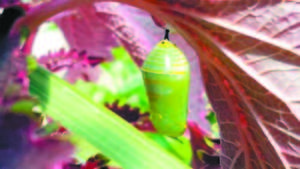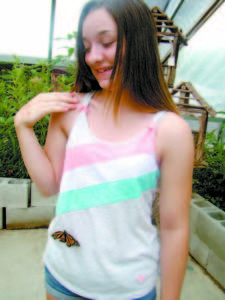Butterfly pavilion: Watching Monarchs a royal treat

BUTTERFLY ON THE NOSE of a customer who was not satisfied with monarch butterflies only on his fingers. This photo was posted on the Facebook page of Mark’s Lawn and Garden to spread the word about the Butterfly Pavilion. (Photo courtesy of Mark’s Lawn and Garden)
By Dawn De Busk
Staff Writer
For the monarch butterfly, the birthdate predicts the future.
Lucky are the butterflies born in late August for they will make the world-renown migration of almost 3,000 miles to Mexico, where they will spend the winter. In the spring, those monarchs will return to their North American homes.
The August-born butterflies will live a long life: Eight to nine months.
Meanwhile, most monarchs born earlier in the summer have a lifespan of two to four weeks as an adult.
The varied life cycles of the monarch (egg, larvae or caterpillar, chrysalis, butterfly) can be seen up close and personal at Mark’s Lawn and Garden.
The business — located at 688 Portland Rd. in Bridgton — has created a suitable ecosystem for the monarch to survive.
The butterfly houses were built in 2015.

CREATION IN CHRYSALIS — After munching on the milkweed plant, the monarch caterpillar forms a chrysalis, from which it will emerge as a butterfly. (Photo courtesy of Mark’s Lawn and Garden)
The purpose of the Butterfly Pavilion is two-prong: to help maintain the monarch population, which has dropped by 15% nationwide, and also to provide residents and visitors with another option for summer activities, according to Operations Manager Ron Arzilli.
“The objective is to increase the population of monarch butterflies in Maine,†he said.
“Our goal is to grow a thousand or more butterflies each year to tag and release in September when they will hopefully migrate to Mexico and perpetuate more monarchs to return to Maine for future generations,†he said.
The butterfly houses are all about raising public awareness about the decline of the monarch, he said.
The decrease of monarchs has been recorded in photographs of the wintering sites in Mexico. Scientists are uncertain if the decline is tied to use of herbicides or urban sprawl, the loss of land where milkweed once grew, or a combination of both.
While education is great and knowledge is power, the visual experience of the Butterfly Pavilion is purely enlightening.
“Most people come and see it and are totally blown away,†Arzilli said.

HESITANT BUT DELIGHTED —Danielle Gordon, 13, of Casco, decided to let a butterfly crawl on her shirt instead of allowing it to lick nectar from her finger. People can feed monarchs at the Butterfly Pavilion, which is open from 10 a.m. to 5 p.m. daily, at Mark’s Lawn and Garden. (De Busk Photo)
A female butterfly can lay up to 400 eggs at a time. Those eggs appear as tiny white dots on the underside of the milkweed leaf. There are dozens of smooth, striped caterpillars munching on the milkweed plants. At the same time, there are hundreds of active monarch butterflies, gliding from flower to flower.
“Fifty of them just emerged from the chrysalis†on Friday morning, Arzilli said.
The butterfly exhibit at the York’s Wild Kingdom has far fewer butterflies compared to the one in Bridgton, he said.
The royal treat for visitors to the monarch houses at Mark’s Lawn and Garden is when employee Colleen Messina helps with the process of getting butterflies to alight on people. Affectionately called “the butterfly whisperer,†Colleen squeezes the nectar from a nicotinana flower onto the person’s finger, and then she encourages them to gently nudge a feeding monarch. Usually, the monarch will lap the nectar with its tiny tongue.
A few weeks ago, two women from Vermont visited the pavilion during their stay in the Lake Region. According to Arzilli, the women were delighted with the setup. They posted photos of themselves and their monarch friends on Facebook.
According to Arzilli, the monarchs “are very active in the morning and in the late afternoon.â€
The Butterfly Pavilion is open to the public from 10 a.m. to 5 p.m. daily.
“It’s something to do on a rainy day with out-of-town friends,†he said.
Or, a trip to the pavilion can be planned with school-aged children.
“It’s a great educational experience,†Arzilli said.
People can learn more about which plants to put in their garden to attract monarchs.
Although milkweed does not rate as the most popular garden plant, it is vital to the monarch. Also, Mark’s Lawn and Garden offers a few varieties of the milkweed. People who visit the pavilion get a discount on the plant purchase.
“We are pushing people to plant†the varieties of milkweed, he said.
According to the travel website Mexperience, “Milkweed plants provide an essential food source for their caterpillars. The milkweed contains a chemical that is toxic to many species, but which monarchs can, uniquely, assimilate and store in the cells of its outer skin. This, in turn, provides the butterfly with a powerful defense ‘shield’ against potential predators.â€
Natural wildlife websites explain that milkweed is the only host plant for the monarch in its caterpillar form.
According to Arzilli, it is a process of changing people’s mindset to get them to support the idea of growing plants that will be devoured by caterpillars.
“For some people it is about the beautiful garden. They don’t want to see chewed up leaves,†he said.
Some customers at Mark’s Lawn and Garden and visitors to the pavilion have commented that they have noticed there are no longer monarchs where they used to live, he said. This anecdotal evidence adds to the scientific studies that the number of monarchs has fallen. Reversing that trend is a worthwhile goal, Arzilli said.
For now, people can go to the Butterfly Pavilion to get emerged in the world of monarchs.

